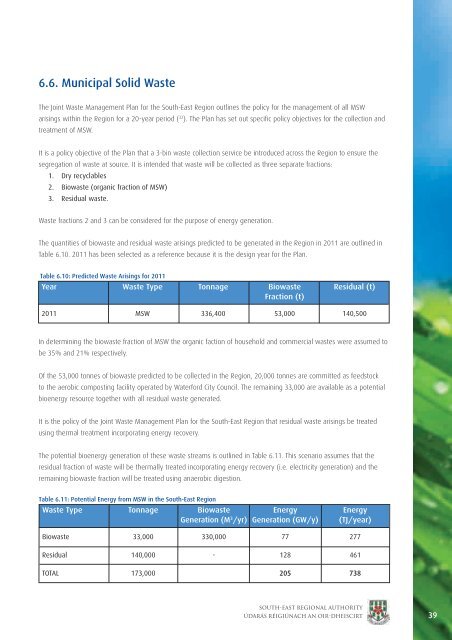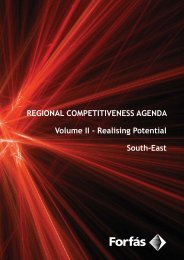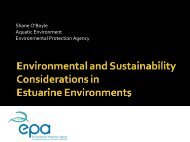Bioenergy Implementation Plan - South-East Regional Authority
Bioenergy Implementation Plan - South-East Regional Authority
Bioenergy Implementation Plan - South-East Regional Authority
Create successful ePaper yourself
Turn your PDF publications into a flip-book with our unique Google optimized e-Paper software.
6.6. Municipal Solid Waste<br />
The Joint Waste Management <strong>Plan</strong> for the <strong>South</strong>-<strong>East</strong> Region outlines the policy for the management of all MSW<br />
arisings within the Region for a 20-year period ( 32 ). The <strong>Plan</strong> has set out specific policy objectives for the collection and<br />
treatment of MSW.<br />
It is a policy objective of the <strong>Plan</strong> that a 3-bin waste collection service be introduced across the Region to ensure the<br />
segregation of waste at source. It is intended that waste will be collected as three separate fractions:<br />
1. Dry recyclables<br />
2. Biowaste (organic fraction of MSW)<br />
3. Residual waste.<br />
Waste fractions 2 and 3 can be considered for the purpose of energy generation.<br />
The quantities of biowaste and residual waste arisings predicted to be generated in the Region in 2011 are outlined in<br />
Table 6.10. 2011 has been selected as a reference because it is the design year for the <strong>Plan</strong>.<br />
Table 6.10: Predicted Waste Arisings for 2011<br />
Year Waste Type Tonnage Biowaste Residual (t)<br />
Fraction (t)<br />
2011 MSW 336,400 53,000 140,500<br />
In determining the biowaste fraction of MSW the organic faction of household and commercial wastes were assumed to<br />
be 35% and 21% respectively.<br />
Of the 53,000 tonnes of biowaste predicted to be collected in the Region, 20,000 tonnes are committed as feedstock<br />
to the aerobic composting facility operated by Waterford City Council. The remaining 33,000 are available as a potential<br />
bioenergy resource together with all residual waste generated.<br />
It is the policy of the Joint Waste Management <strong>Plan</strong> for the <strong>South</strong>-<strong>East</strong> Region that residual waste arisings be treated<br />
using thermal treatment incorporating energy recovery.<br />
The potential bioenergy generation of these waste streams is outlined in Table 6.11. This scenario assumes that the<br />
residual fraction of waste will be thermally treated incorporating energy recovery (i.e. electricity generation) and the<br />
remaining biowaste fraction will be treated using anaerobic digestion.<br />
Table 6.11: Potential Energy from MSW in the <strong>South</strong>-<strong>East</strong> Region<br />
Waste Type Tonnage Biowaste Energy Energy<br />
Generation (M 3 /yr) Generation (GW/y) (TJ/year)<br />
Biowaste 33,000 330,000 77 277<br />
Residual 140,000 - 128 461<br />
TOTAL 173,000 205 738<br />
south-east regional authority<br />
údarás réigiúnach an Oir-DheisCIrt<br />
39





